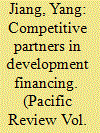| Srl | Item |
| 1 |
ID:
167636


|
|
|
|
|
| Summary/Abstract |
In the aftermath of the global financial crisis, with the world in search for new economic engines, China and Japan have explicitly given their answer through their expansion of overseas infrastructure investments. This study focuses on the flagship sector of high-speed railways (HSR) and examines what kinds of development financing China and Japan have adopted in making these investments. It asks the following questions: What similarities are there in the Chinese and Japanese approaches to investments in overseas infrastructure, and how do they differ from traditional Western development financing? Also, in what ways have China and Japan changed their approaches to overseas infrastructure projects during this process? It argues that in the process of expanding overseas infrastructure investments and competing for infrastructure projects, China and Japan have become ‘competitive partners’ in challenging the traditional norms of development financing represented by the Washington Consensus and the Development Assistance Committee (DAC). To be more specific, China and Japan have adopted each other’s practices of tied commercial financing, heavy government involvement, focusing on physical infrastructure and industrialization, and showing respect for host-country forms of governance. In particular, by joining China in the new game of exporting infrastructure and through its own ‘quality infrastructure investment’ initiative, Japan has broken out of the constraints of DAC norms as an aid donor and endorsed some fundamental Chinese approaches to development and development cooperation, which in their turn were inspired by earlier Japanese practices.
|
|
|
|
|
|
|
|
|
|
|
|
|
|
|
|
| 2 |
ID:
192547


|
|
|
|
|
| Summary/Abstract |
The rise of China and the introduction of the Belt and Road Initiative have intensified regional great power competition. Seemingly, China and Japan have been competing over the export of infrastructure projects and access to the Southeast Asian market. Against this backdrop, this paper sheds light on recipient states’ agency. Specifically, this paper explores how Indonesia has responded to Sino-Japanese competition through the perspective of economic hedging. In the realm of domestic railway development and the need to establish connectivity on Java, why did the Indonesian government decide to work with China to develop the Jakarta-Bandung High-speed Rail project and Japan on the North Java Upgrading Line, as the two lines are not interoperable? Railway policy in Indonesia is strategic and pragmatic. On the one hand, Sino-Japanese competition diversifies Indonesia’s options as it continues striving to strengthen infrastructure development. On the other hand, the need continually to strike a balance between the two great powers requires skill and flexibility. Therefore, maintaining policy autonomy and accepting economic costs make-up secondary states’ responses to great power competition in turbulent times.
|
|
|
|
|
|
|
|
|
|
|
|
|
|
|
|
| 3 |
ID:
182721


|
|
|
|
|
| Summary/Abstract |
Using high-speed railway (HSR) construction in China as a quasi-experiment, this paper contributes to the understanding of how transportation infrastructure affects entrepreneurship. On the basis of a difference-in-difference approach, we find that access to an HSR connection leads to an increase in entrepreneurship by approximately 3.5 percentage points (35% of the mean). Mechanism exploration suggests that market potential is the main channel that HSR encourages entrepreneurial activities, which is realized by accelerated information sharing and face-to-face interactions. And the effect is bigger for high-educated families, wealthy families and in large cities.
|
|
|
|
|
|
|
|
|
|
|
|
|
|
|
|